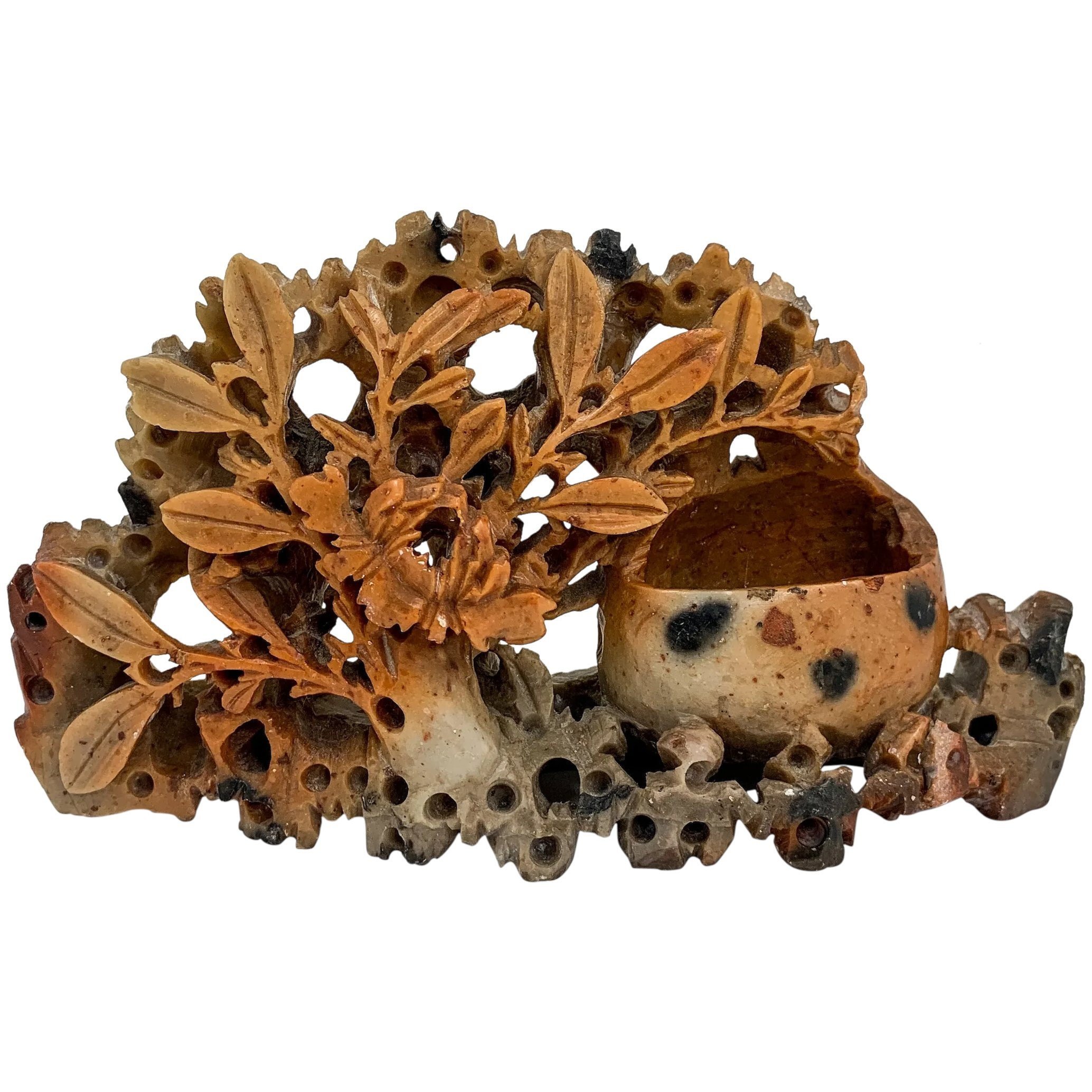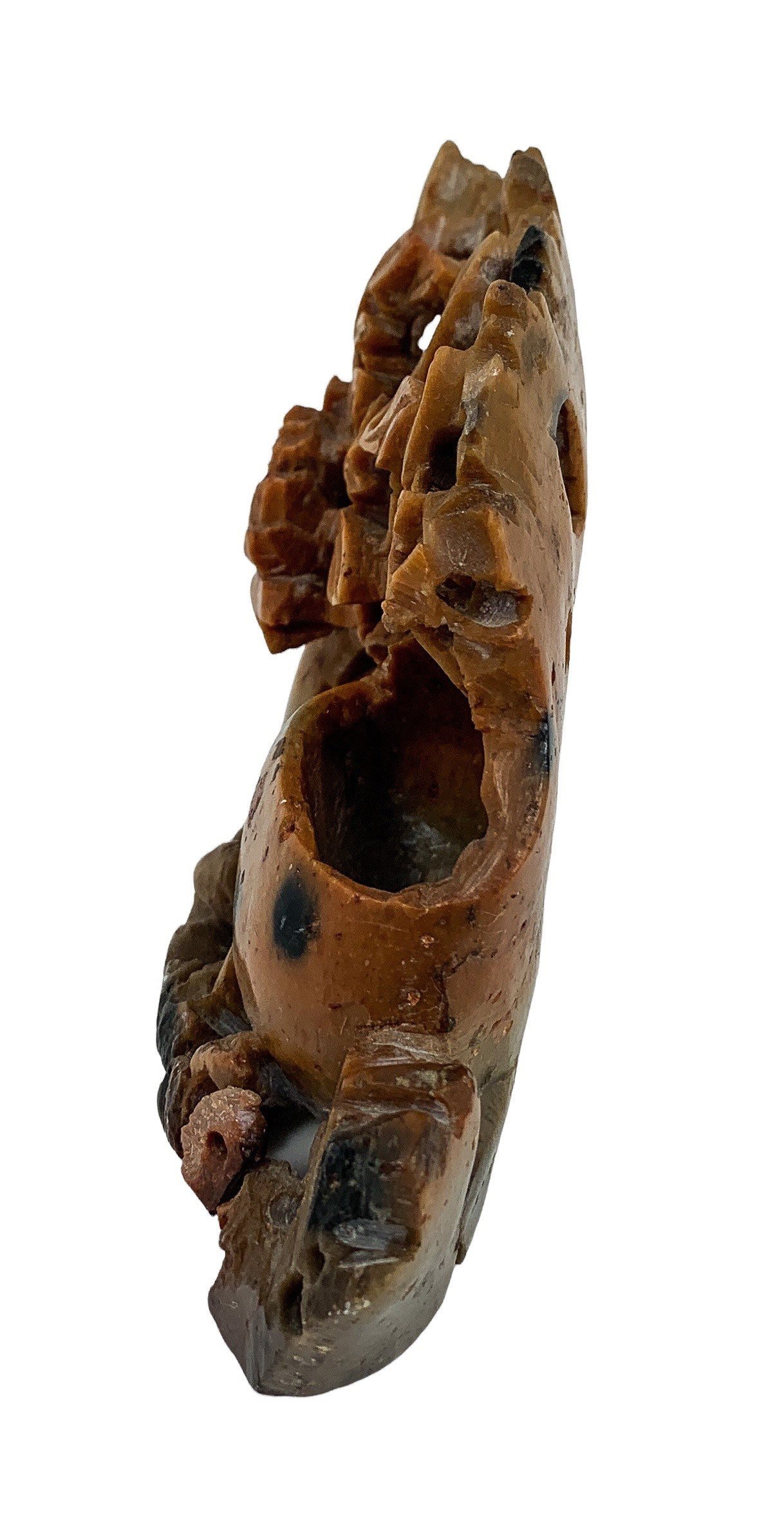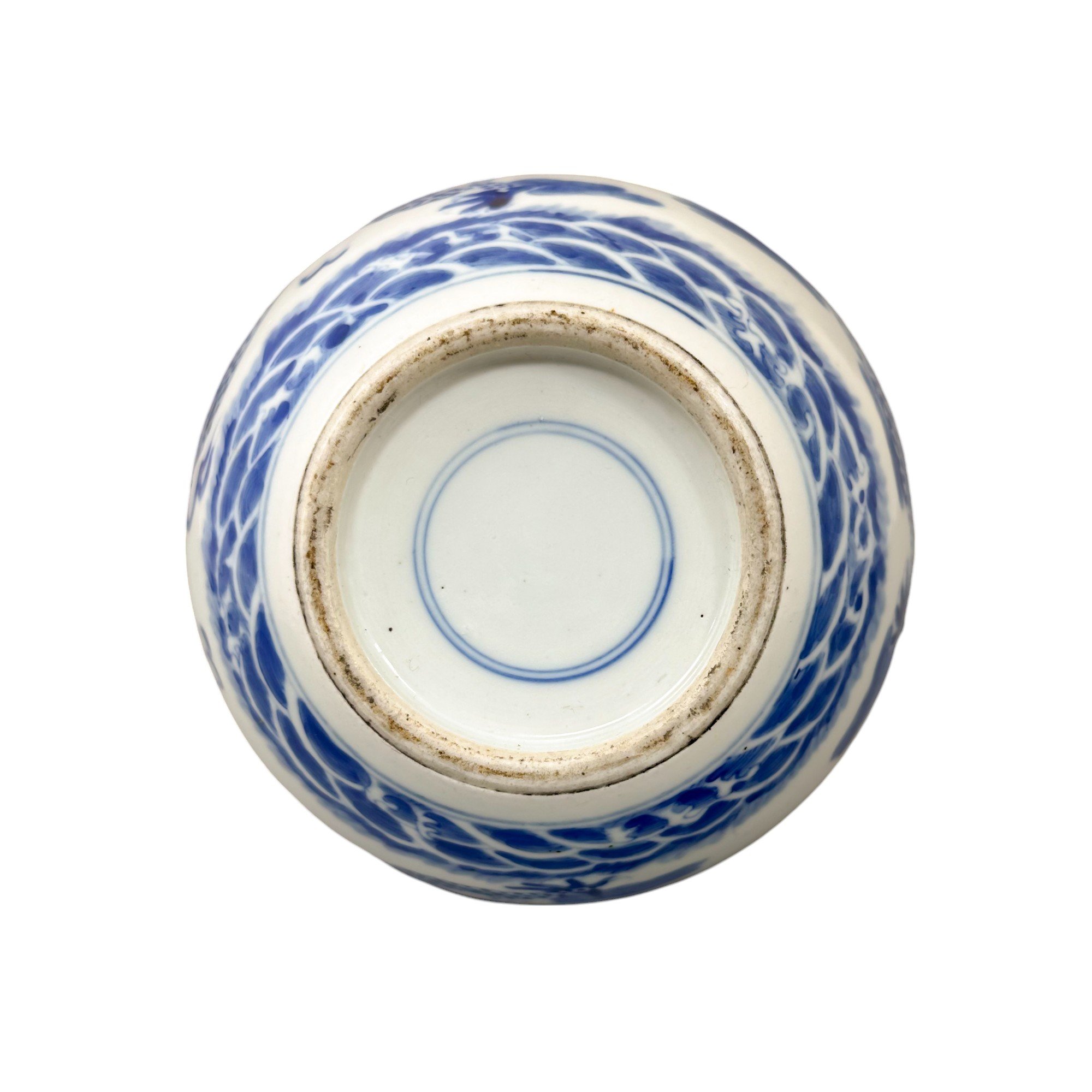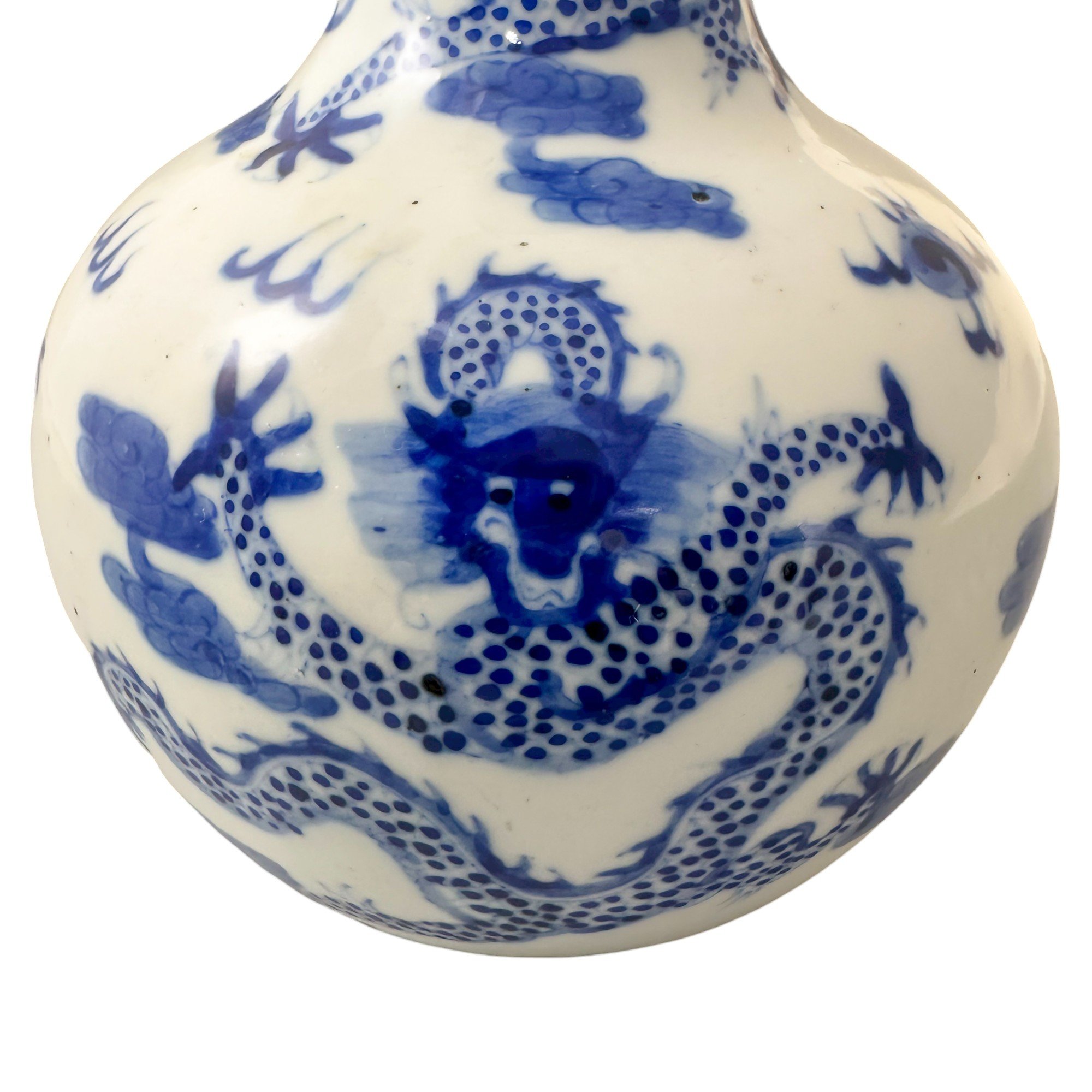 Image 1 of 6
Image 1 of 6

 Image 2 of 6
Image 2 of 6

 Image 3 of 6
Image 3 of 6

 Image 4 of 6
Image 4 of 6

 Image 5 of 6
Image 5 of 6

 Image 6 of 6
Image 6 of 6







19th century Chinese Shiwan Ware monk figurine
Antique Shiwan Ware Monk Figurine, Hand-Formed Chinese Pottery, c. 1880-1940
A finely crafted 'Jun' glazed Shiwan ware figurine, depicting a monk enjoying a cup of tea. The first striking element is the detailed and expressive face, skilfully sculpted to capture the essence of contemplation. His variegated brown robe has a richly textured glaze, enhancing the depth and artistry of this traditional Chinese ceramic piece.
During the Qing dynasty, the shaved forehead symbolised Manchu authority and cultural dominance. This feature held strong symbolic meaning, representing virility and social status.
Historical Background
Shiwan (Shekwan) ware is one of the most celebrated forms of Chinese folk ceramic art, originating as early as the Tang and Song Dynasties (618-906 AD) and flourishing in the Ming and Qing dynasties. The town of Shiwan, located in Foshan City, became renowned for its masterful glazing techniques and expressive sculptural forms.
Each Shiwan figurine is hand-formed, often involving multiple craftsmen within a family or village, under the direction of a master artisan. Due to their delicate nature, original Shiwan figurines (1880-1940) are extremely rare. Larger pieces over 20 cm are considered especially valuable, as they required exceptional skill to create.
The age of Shiwan ware can be determined by the lack of markings, primitive sculpting techniques, deep rich glazes, and the use of coarse regional clay. Early Shiwan pieces, predating 1890, are typically unsigned.
Shiwan ware is distinct from mudmen figures, which were mass-produced for bonsai, planters, and aquariums. Unlike these molded or finger-formed export pieces, Shiwan ceramics stand out for their unique hand-sculpted artistry and vivid detailing.
A figure in the same style can be seen at the Victoria and Albert Museum.
Measurements
Height: 21.5 cm
Length: 7.8 cm
Width: 6 cm
Weight: 638 g
Condition
Excellent antique condition. No chips, missing elements, or repairs. The original glaze and craftsmanship are beautifully preserved.
Antique Shiwan Ware Monk Figurine, Hand-Formed Chinese Pottery, c. 1880-1940
A finely crafted 'Jun' glazed Shiwan ware figurine, depicting a monk enjoying a cup of tea. The first striking element is the detailed and expressive face, skilfully sculpted to capture the essence of contemplation. His variegated brown robe has a richly textured glaze, enhancing the depth and artistry of this traditional Chinese ceramic piece.
During the Qing dynasty, the shaved forehead symbolised Manchu authority and cultural dominance. This feature held strong symbolic meaning, representing virility and social status.
Historical Background
Shiwan (Shekwan) ware is one of the most celebrated forms of Chinese folk ceramic art, originating as early as the Tang and Song Dynasties (618-906 AD) and flourishing in the Ming and Qing dynasties. The town of Shiwan, located in Foshan City, became renowned for its masterful glazing techniques and expressive sculptural forms.
Each Shiwan figurine is hand-formed, often involving multiple craftsmen within a family or village, under the direction of a master artisan. Due to their delicate nature, original Shiwan figurines (1880-1940) are extremely rare. Larger pieces over 20 cm are considered especially valuable, as they required exceptional skill to create.
The age of Shiwan ware can be determined by the lack of markings, primitive sculpting techniques, deep rich glazes, and the use of coarse regional clay. Early Shiwan pieces, predating 1890, are typically unsigned.
Shiwan ware is distinct from mudmen figures, which were mass-produced for bonsai, planters, and aquariums. Unlike these molded or finger-formed export pieces, Shiwan ceramics stand out for their unique hand-sculpted artistry and vivid detailing.
A figure in the same style can be seen at the Victoria and Albert Museum.
Measurements
Height: 21.5 cm
Length: 7.8 cm
Width: 6 cm
Weight: 638 g
Condition
Excellent antique condition. No chips, missing elements, or repairs. The original glaze and craftsmanship are beautifully preserved.
Antique Shiwan Ware Monk Figurine, Hand-Formed Chinese Pottery, c. 1880-1940
A finely crafted 'Jun' glazed Shiwan ware figurine, depicting a monk enjoying a cup of tea. The first striking element is the detailed and expressive face, skilfully sculpted to capture the essence of contemplation. His variegated brown robe has a richly textured glaze, enhancing the depth and artistry of this traditional Chinese ceramic piece.
During the Qing dynasty, the shaved forehead symbolised Manchu authority and cultural dominance. This feature held strong symbolic meaning, representing virility and social status.
Historical Background
Shiwan (Shekwan) ware is one of the most celebrated forms of Chinese folk ceramic art, originating as early as the Tang and Song Dynasties (618-906 AD) and flourishing in the Ming and Qing dynasties. The town of Shiwan, located in Foshan City, became renowned for its masterful glazing techniques and expressive sculptural forms.
Each Shiwan figurine is hand-formed, often involving multiple craftsmen within a family or village, under the direction of a master artisan. Due to their delicate nature, original Shiwan figurines (1880-1940) are extremely rare. Larger pieces over 20 cm are considered especially valuable, as they required exceptional skill to create.
The age of Shiwan ware can be determined by the lack of markings, primitive sculpting techniques, deep rich glazes, and the use of coarse regional clay. Early Shiwan pieces, predating 1890, are typically unsigned.
Shiwan ware is distinct from mudmen figures, which were mass-produced for bonsai, planters, and aquariums. Unlike these molded or finger-formed export pieces, Shiwan ceramics stand out for their unique hand-sculpted artistry and vivid detailing.
A figure in the same style can be seen at the Victoria and Albert Museum.
Measurements
Height: 21.5 cm
Length: 7.8 cm
Width: 6 cm
Weight: 638 g
Condition
Excellent antique condition. No chips, missing elements, or repairs. The original glaze and craftsmanship are beautifully preserved.







































